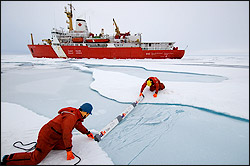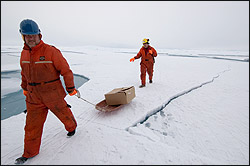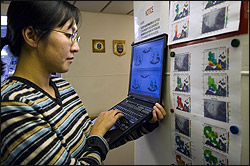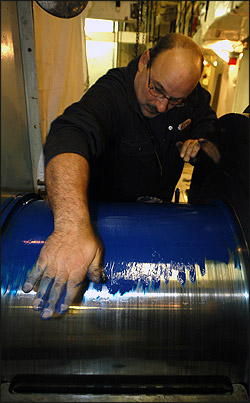Please note: You are viewing
the unstyled version of this website. Either your browser does not support CSS
(cascading style sheets) or it has been disabled. Skip
navigation.
Chris LinderAugust 22, 2005
After auguring the first hole in the ice, a voice cut in on Neil Jollymore's radio. "This is the Chief Officer. A crack has opened between you and the ship--come back immediately." We all heard the message loud and clear. In minutes we had all of the gear packed back up and had dragged it back to the ship. On the way we passed over the crack, only an inch or so wide but running for fifty feet right across the floe. Other hairline cracks appeared to be spreading from the large crack. Back on deck, I asked Chief Officer Ken Brown what might have caused the crack to suddenly appear, after four days being stationary in the ice. "Well, I'm not positive, but the strong wind this morning may have had something to do with it. The Louis catches the wind like a sail, and she gets pushed faster than the surrounding ice. That can cause pressure to build up in the ice, and ultimately crack it." The buoy deployment is called off for the day, while we watch the crack to see how it develops. After supper I made a trip down to the engine room to see how things were coming along on the repairs to the starboard shaft. The mood was considerably more optimistic than the past few days. I watched as the bottom half of the forward engine bearing was lowered into place and tested. The engine department should be proud of their efforts. The repairs they are completing are so extensive that they would normally have been carried out in a shipyard, not floating in the middle of the Beaufort Sea. The latest prediction is that we could be steaming again on Wednesday or Thursday. Tonight we celebrated an important anniversary for the Louis. Eleven years ago on this day, the Louis S. St-Laurent and the US Coast Guard icebreaker Polar Sea became the first surface ships from Canada and the United States to reach the North Pole. We watched a video documentary on that historic international expedition. I found it particularly interesting that at about the same time as our shaft failure last week, the Polar Sea suffered a major setback when one of her propellers sheared off. Coincidence, or more evidence for Rick Krishfield's Beaufort Triangle theory? We also recognized some familiar faces in the video--Doug Sieberg from the science party and Mark Lewis from the crew. In addition, crew members Dale Hiltz, David Baur, and Sandy Myers were on the Louis in 1994. Even though we had to abort today's buoy deployment, the mission is back on the schedule for tomorrow. The crack is small, and if it hasn't widened significantly the mooring team is going to try to deploy both buoys just after breakfast. Last updated: October 7, 2019 | ||||||||||||||||||||||
Copyright ©2007 Woods Hole Oceanographic Institution, All Rights Reserved, Privacy Policy. | ||||||||||||||||||||||






